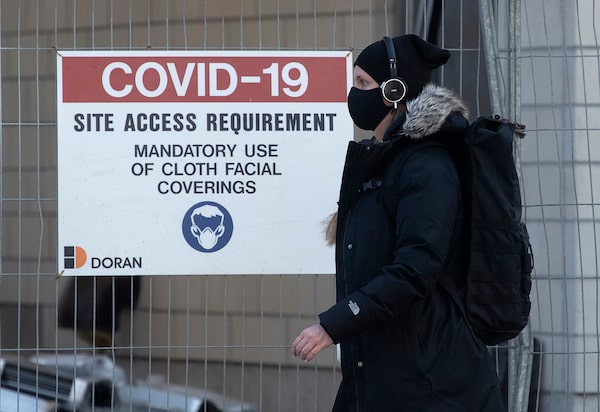
A pedestrian walks past signs on a construction site fence in Ottawa on Thursday. Ottawa, along with the rest of Ontario, has entered what’s being called a shutdown by the government, however with measures significantly less strict than those across the river in Gatineau.Adrian Wyld/The Canadian Press
The Friday night before provincial restrictions would once again force restaurants to close, many Ottawa residents ventured out to their favourite spot for one last meal, dining in or eating outside. A different scenario unfolded on the opposite side of the river in Gatineau, which had already moved into a strict lockdown.
It’s the tale of two cities separated only by a river. Ottawa and Gatineau are deeply intertwined with residents working, dining and visiting with friends on each side.
Despite how entangled the cities are, their COVID-19 restrictions have been out of step: Rules have been more lax in this region of Ontario than in Quebec. Now, as provincial governments confront a third wave of the pandemic that is threatening to overwhelm hospitals, Gatineau residents are staring down tougher restrictions than their neighbours.
Is my area going back into COVID-19 lockdown? A guide to restrictions across Canada
Gatineau began a strict 10-day lockdown on Thursday, which meant non-essential businesses and schools had to close and there is a curfew from 8 p.m. to 5 a.m.
Ottawa, along with the rest of Ontario, entered on Saturday what’s being called a shutdown by the government, however with measures significantly less strict than those across the river.
In Ottawa, non-essential businesses are open – with capacity limits. In grocery stores, convenience stores, indoor farmers’ markets and pharmacies, the capacity limit is 50 per cent. In all other retail stores, including big box stores, the limit is 25 per cent.
Last-minute restrictions imposed on a long weekend meant long lineups and overcrowding. At the Dollarama on Saturday, a cashier had to kindly explain to an elderly woman that she had to stay two metres from the person next to her, while another employee anxiously counted shoppers to ensure the store was not exceeding its limit.
And unlike Gatineau, there is no curfew and so far, schools are open.
Having grown up in Ottawa, Gerald Evans, chair of the division of Infectious Diseases at Queen’s University, is familiar with the unique dynamic between the two cities.
He said having more stringent restrictions on one side can lead people to take advantage of whichever side has slacker restrictions.
Dr. Evans said he sees the curfew as one of the most striking differences between the two cities and has heard, at least anecdotally from colleagues, that it has been effective.
“Now, with the rise of cases in the third wave with variants and everything else, I think Quebec has … taken a bit more of a stringent approach than what’s been done in Ontario,” he said.

A car leaves Gatineau as it heads into Ontario on Jan. 9, 2021, as a provincewide curfew begins in Quebec. Gatineau began a strict 10-day lockdown on April 1.Adrian Wyld/The Canadian Press
COVID-19 infections are surging in both provinces, driven largely by highly contagious variants that are landing younger people in hospitals. Both provinces announced tougher pandemic restrictions last week in a bid to slow the rising cases, but Quebec’s tougher measures exclude Montreal and Ontario’s restrictions keep all retail shops and malls open.
Ontario’s hospital association is warning that if the number of admissions to intensive care units continues to increase, as expected, hospitals will be under extraordinary pressure to try to ensure equitable access to life-saving critical care.
Ottawa Public Health reported on average 167 cases a day over the past seven days. The Outaouais region, which includes Gatineau, reported an average of 108 daily cases in the same time frame.
Last week, Quebec Premier François Legault said he is in talks with the Ontario government to harmonize the restrictions for Ottawa and Gatineau – a proposal Dr. Evans said has value because the populations mix.
“Our measures are tougher,” Mr. Legault said, citing the province’s curfew and pointing out that in Quebec’s red zone restaurants are closed.
Before both cities entered into new lockdowns in recent days, Ottawa moved into the orange-restrict zone in February and was moved into the red zone one month later. Gatineau had moved into its orange zone a week after Ottawa had in February. The colour, though, meant different things for the two cities.
In Ottawa’s orange zone, social gatherings in private homes or backyards were allowed again, restricted to 10 people inside and 25 people outside. Restaurants and bars could have 50-per-cent capacity, and people outside had to keep a two-metre distance from one another.
In Gatineau, unnecessary gatherings with family and friends are not allowed. There was previously a curfew between 9:30 p.m. and 5 a.m. Indoor or outdoor gatherings are prohibited except for a person who lives alone, with their dependent children. Exceptions are also made for an informal caregiver, or someone offering a service or support. Restaurants were open, but with a maximum of two adults from different addresses sitting at the same table, but who may be joined by their children. Bars were kept closed.
The red zones in each province also differed. In Ontario, residents are advised not to visit other households, but if you live alone, you can have close contact with one other household. Social gatherings indoors are capped at five and outside, 25. Restaurants are open, but residents must sit with their household. Stores are open with capacity limits.
In Quebec, a curfew remains, indoor and outdoor gatherings in private homes are prohibited, apart from exceptions that also exist in the orange zone. Restaurants are closed for indoor dining and bars are still closed.
Dr. Vera Etches, Ottawa’s Medical Officer of Health, tweeted on Sunday that Ottawa moved into the red zone as COVID-19 levels were rising two weeks ago – and the curve has only worsened. She wrote that two weekends ago the city had lovely weather and a lot of socializing.
“I am seeing many people test positive after being in groups at restaurants, with transmission even outdoors,” Dr. Etches said on Twitter. She said vaccination will not “turn this curve” and there is not enough vaccine to protect everyone from this resurgence.
“Enjoy the outdoors for physical activity with members of your household only,” she said, adding that people who have contact with those not in the same household, apart from single people or those who require support, need to keep two metres distance and wear masks.
Health columnist André Picard answers reader questions about COVID-19 variants, how effective the various vaccines are and the impact of on-again, off-again lockdowns.
The Globe and Mail
Sign up for the Coronavirus Update newsletter to read the day’s essential coronavirus news, features and explainers written by Globe reporters and editors.
 Janice Dickson
Janice Dickson